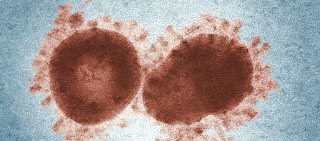 |
| CDC, under Unsplash license |
You know how in some cases Superman and Lex Luthor need to collaborate against another, more noteworthy danger?
Presently, analysts at the Mayo Clinic have shaped an impossible crew from beefed up insusceptible framework cells, called CAR-T cells, with disease killing infections, otherwise called oncolytic infections, to bring down strong growths.
The blend demonstrated compelling in mouse models of disease, relieving cerebrum cancers and melanomas in numerous destinations in mice, and assisting mice with living longer, with a supporter shot of the infection expanding insurance against growths framing once more.
"This approach permits the growth to be killed by the infection as well as by the CAR-T cells," Richard Vile, co-head of the Gene and Virus Therapy Program inside Mayo Clinic Cancer Center, said in an explanation.
Scientists at the Mayo Clinic have consolidated beefed up resistant framework cells, called CAR-T cells, with malignant growth killing infections to bring down strong cancers.
Super cells: The Mayo group's review, distributed in Science Translational Medicine, joined two distinct sorts of malignant growth battling treatments: CAR-T immunotherapy and oncolytic infection treatment.
The thought behind immunotherapy is an effortless one — use the body's own safe framework to battle malignant growth.
Disease, tragically, isn't effectively battled. Growths have various methods for avoiding the invulnerable framework, including fake atoms, hereditary changes which work like disguise, insusceptible cell-destroying surface proteins, and ruining close by cells to make safeguards.
All of this makes a "microenvironment" around the growth which makes it hard for the insusceptible framework to get through; think about it like a hid malicious fort.
One technique for assisting your resistant cells with doing what they specialize in is by giving them another weapon: an illusory antigen receptor, or CAR. The CAR assists the safe cells with spotting destructive cells any place they are, which they will then, at that point, continue to give the business.
Vehicle T cells are a particular kind of these cells, which has seen a positive outcome against diffuse blood-borne tumors.
Vehicle T treatment comes up short with regards to battling the invigorated strong cancers, notwithstanding, driving analysts to track down better approaches to enable the cells.
Infections versus disease: To get at strong cancers, Mayo Clinic group banded together their CAR-T cells with oncolytic infections.
While infusing yourself with an infection to battle disease might sound weird, the treatment can be successful. Altered HSV-1 oncolytic infections are supported by the FDA for battling melanoma, while a little report showed that herpesviruses additionally can possibly fight ruthless pediatric mind malignant growth.
Twofold difficulty, cancers! The Mayo group altered CAR-T cells to ship a payload of oncolytic infections directly to the strong growths. The infections then, at that point, taint the disease cells, reproduce, and rip them open — killing the malignant growth cells straightforwardly as well as starting an overall insusceptible reaction to the area.
"What's more, when the infection is conveyed, it transforms the cancer into an exceptionally fiery climate, which the patient's own safe framework then, at that point, sees and begins to assault," Vile said.
At the point when the analysts tried their platooned CAR-T cells and oncolytic infections in mouse models of melanoma and mind growths, they had the option to fix the cancers at different destinations without causing elevated degrees of poisonousness.
"Clinically, conveying the treatment fundamentally is a potential benefit since you might actually treat patients with metastatic illness without infusing every growth," Vile said.
The joined treatment was more powerful than either CAR-T cells or oncolytic infections alone.
At the point when a sponsor shot of the equivalent oncolytic infections was infused into the treated mice, it appeared to set off an insusceptible memory reaction, with the CAR-T cells getting a move on shielding six of seven mice from cancer renewal for 60 days, FierceBiotech detailed.
"By putting the infection onto the CAR-T, we enact them against both the infection and the growth, and they get immunological memory," Vile said.
A supporter shot of the equivalent infections broadened growth security in mouse models.
"This permits us to give a lift with the infection sometime in the not too distant future point, which thusly makes the CAR-T cells awaken once more and go through extra adjusts of killing the growth."
The consolidated treatment tends to two of the primary difficulties CAR-T cells face while managing strong growths.
To start with, the oncolytic infections can separate the sub-atomic safeguards some growth cells employ, the scientists said; second, they can strike at the actual center of the disease cells, an assault that resistant cells struggle with pulling off.
Careful positive thinking: Vile underscores that the work is still early, and as the colloquialism goes, "mice lie"; what works in a rat isn't ensured to work in an individual.
"In any case, we are confident that we will actually want to bring this methodology into clinical preliminaries in something like a little while," Vile said.
Acquiring FDA endorsement could be a piece precarious, FierceBiotech detailed, since joining oncolytic infections and disease killing insusceptible cells could be viewed as two distinct items. Then again, in any case, both CAR-T cells and oncolytic infections are as of now endorsed and treating patients all alone.
Whether their collaborating will work for individuals too is not yet clear.
Follow us on Instagram: @scienceyou5.
Similar Topics
How Immune Cells Spot Their Targets
Unraveling Stem Cells’ Secrets: Immortality of Germline Cells and the Function of “Junk DNA”
Researchers stimulate blind retinas using focused ultrasound technology